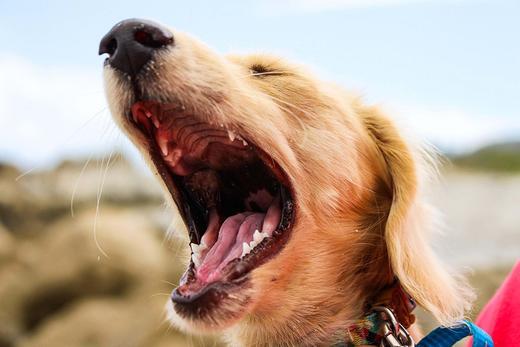Estimated Read Time: 4 ½ minutes
Summary: In this blog we learn all about the dog mouth. We’ll discover what healthy dog gums should look like, teeth of the dog and how to keep your dog’s mouth clean…
A Dog’s Mouth
Like our human mouths, the dog mouth contains a tongue, teeth and gums and the mouth is surrounded by cheeks and lips. It’s located in the front, lower part of the face. Their entire mouth is lined with mucus membranes which manufacture and secrete saliva from their glands, keeping it moist and helping move debris and food down into the throat.
A dog’s tongue, like a human’s, primarily helps guide and process food and water into the oesophagus and has tastebuds which allow your dog to process tastes and scents. A dog’s tongue also helps them regulate their body temperature when they pant, and they also use it to clean themselves and (potentially) their puppies!
A dog’s teeth are used to chew, tear, nibble, carry, puncture and grind food and toys. They are used when playing with other pups or sometimes utilised as a weapon to protect themselves from harm or attack a threat.
Their mouth is also an additional airway, in addition to the nose. The mouth will be used more than the nasal passage to breathe when a dog exercises, becomes excited or if the nose is blocked.

Healthy Dog Gums: What Should A Dog’s Gums Look Like?
A dog’s oral health is essential for helping ensure their overall health, and the colour of their gums can often be a good indicator of where they’re at health-wise. Depending on your dog and their breed, a healthy set of dog gums should be pink, ranging from soft pink to bright pink. A set of dog gums should also be moist.
Some dogs have pigmentation on their gums, causing them to appear black in colour. If they have naturally blacker gums, to be sure your dog’s gum health is in tip-top condition, check the lighter spots on their gums for that essential pink shade, the non-pigmented areas, or check the area underneath their tongue. If you press down on the pink gum, it should turn white. When your finger leaves the gum, it should then pop back to pink pretty much immediately.
How Many Teeth Do Dogs Have?
Adult dogs usually have 42 adult teeth (28 when puppies).
Teeth Of The Dog
Teeth of the dog includes:
Molars; The teeth at the far back of both the upper and lower jaw, these teeth crush and grind.
Premolars; The teeth just before the molars in both jaws, these tear and chew. You’ll know your dog is using their premolars when they tilt their head to one side to chew!
Canines; the long teeth that frame the smaller front teeth, these are used for puncturing and for holding objects in the mouth.
Incisors; the teeth right at the front of both jaws, these are utilised when nibbling, grooming or when stripping meat.
For most doggies, when the jaws close the upper jaw’s incisors just overlap the lower ones. However, with most flat faced breeds (like Boston Terriers, Bulldogs or Pugs), the opposite occurs which can cause issues with eating and make these breeds more prone to tooth decay and gum disease.

Are Dog’s Mouths Cleaner Than Human’s?
Unfortunately, this is a common misconception. Both have a very similar amount of bacteria living in their mouth and both are full of different microbes, some of which appear in both a dog’s and human’s mouth and some which don’t – they’re actually pretty incomparable because of this.
However, both a dog mouth and a human mouth require manual cleaning as both are susceptible to gum disease and tooth plaque and decay. Regular brushing of your dog’s teeth is essential for their overall health as well as their mouth too, as the bacteria that collects in their mouth can make its way down into their body and then make them unwell.
Dog Teeth Cleaning
The key to avoiding teeth and gum issues in your dog’s mouth, is by caring for it as you would your own. Dog’s get plaque build up just like we do, so they need to have their teeth brushed too. In order to help your dog live a happy and full life, cleaning their teeth regularly is imperative.
You should brush your dog’s teeth two/three times a week with a dog enzymatic toothpaste and use dental mouthwash every day. Do not use human toothpaste on dogs, as it may contain ingredients that are harmful and toxic to dogs (such as artificial sweeteners or foaming agents).

PetLab Co. Pro Tip: It’s important to take your dog to the vet for a deep tooth clean at least once a year, preferably twice. These visits also give your vet a chance to do a thorough check, enabling them to spot and respond to any issues before they become big (and expensive!) problems.
Sources
“The Dog Dentition And The Purpose Of Each Teeth” Pedigree https://uk.pedigree.com/caring/my-dogs-health/the-dog-dentition-and-the-purpose-of-each-teeth
Author Dr. Spielman, Bari “Structure And Function Of The Tongue, Teeth And Mouth In Dogs” Aug 03. 2015, Pet Place https://www.petplace.com/article/dogs/pet-health/structure-and-function-of-the-tongue-teeth-and-mouth-in-dogs/





